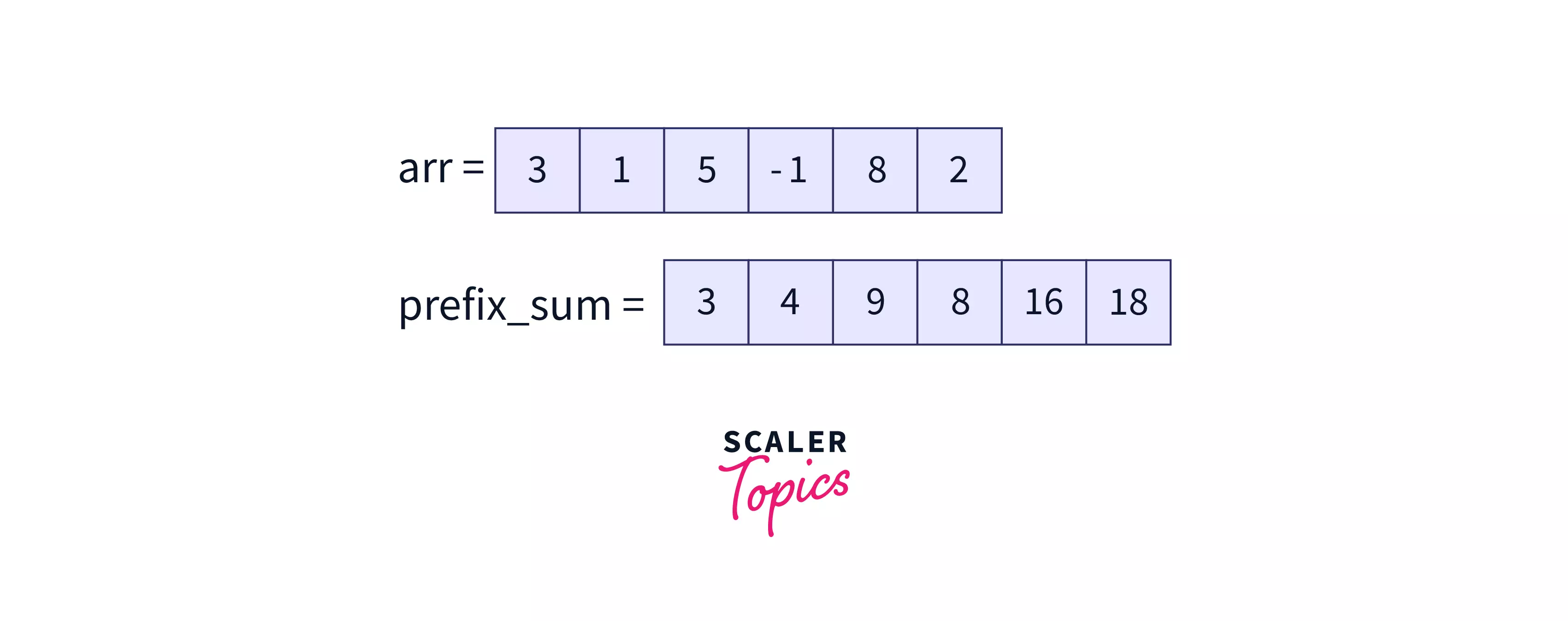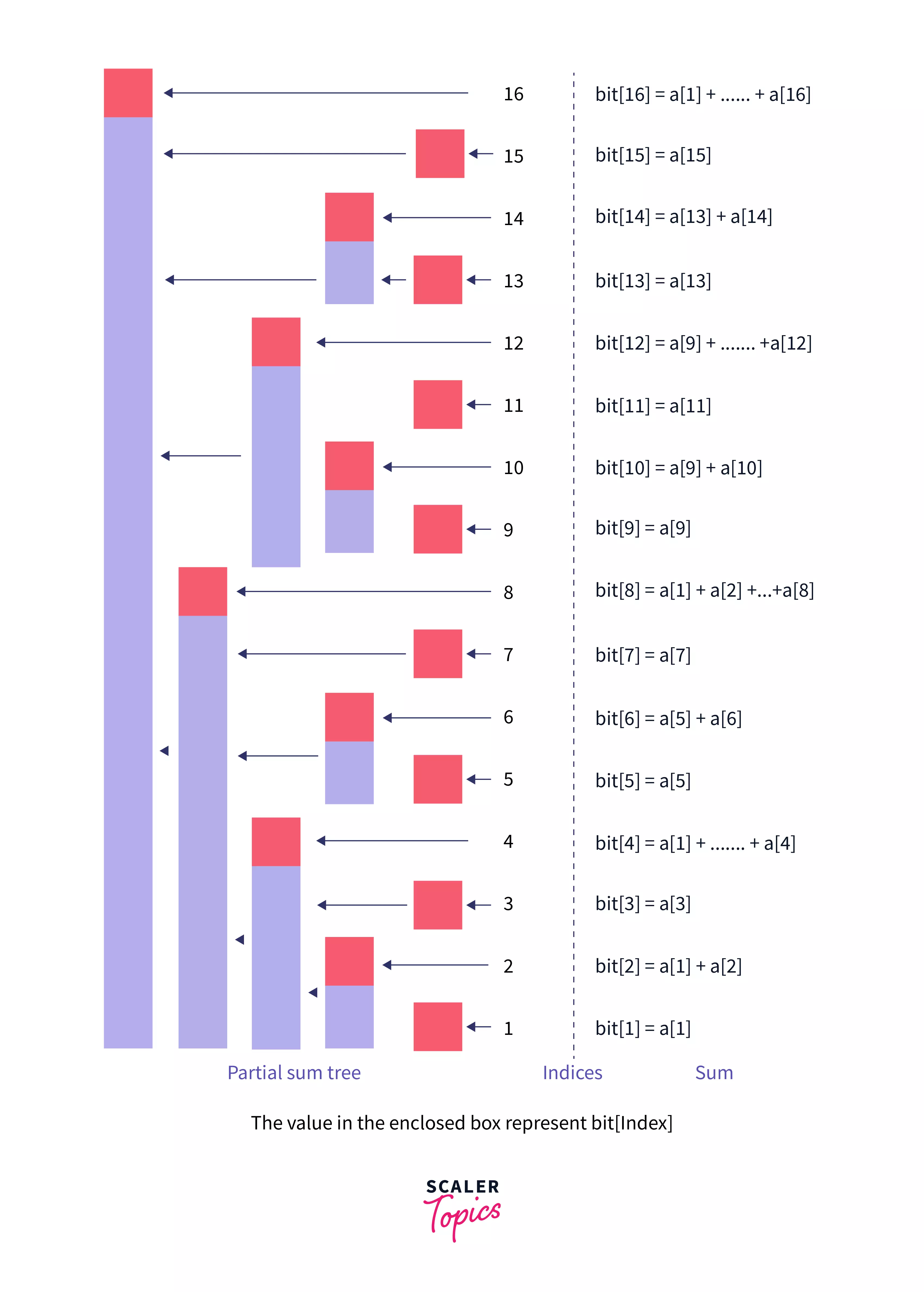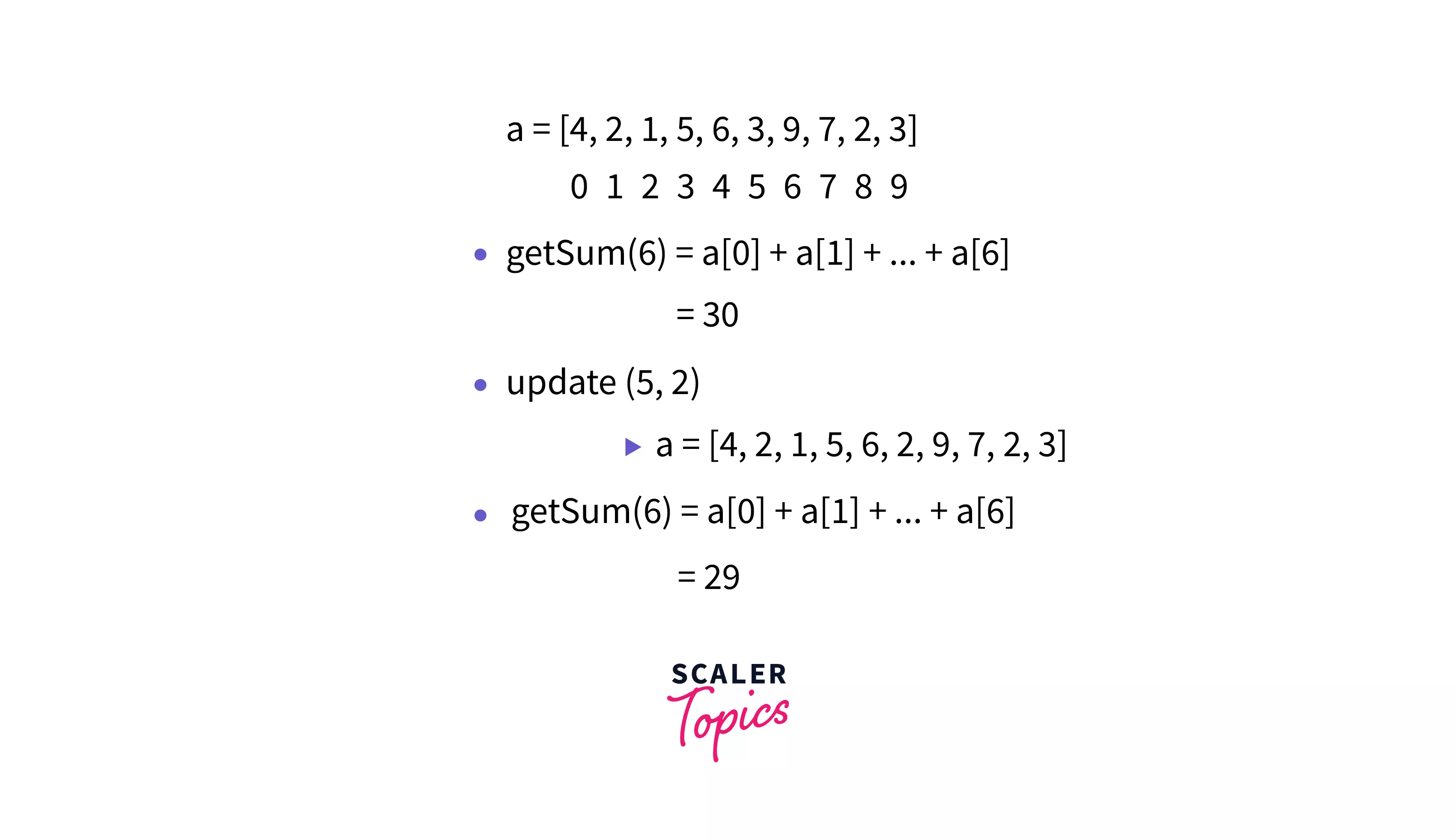The Binary Indexed Tree, also known as the Fenwick tree, provides an efficient way to calculate prefix sums of a series of numbers, especially in scenarios where the values are mutable.
Unlike prefix sum arrays, which excel in answering prefix sum queries but struggle with frequent updates, Fenwick trees offer a balance between efficient query answering and mutable value updates.
By maintaining cumulative frequencies of array elements at each node, Fenwick trees enable prefix sum calculations in logarithmic time complexity.
Utilizing the concept that any integer will be expressed as the sum of powers of 2, Fenwick trees store the sum of a specific range of elements at an index in the auxiliary array, facilitating quick prefix sum computations with minimal space overhead.
For Example:

Representation of Fenwick Tree
The BIT (Binary Indexed Tree) is represented as an array (say $bit$). Where each index of $bit$ stores the sum of a range of elements of the original array (say $a$).
Let $i$ be an index of the array $bit$, then $bit[i]$ will contain the sum of elements ${a[i-2^{x-1}+1]$$\rightarrow a[i]}$ where $x$ is the position of the least significant set-bit in the binary representation of $i$.

Let us understand by an Example:
Let’s say we want to know the range of which sum is stored in $bit[12]$, we know that binary representation of $12$ is $1100$, we can see that the position of least significant set-bit from right, $x$ is $3$.
That means $bit[12]$ will contain the sum of the range $(13-2^{3-1}+1) \rightarrow 12$ $i.e.$ $9 \rightarrow 12$.

The above image represents the range of elements for which the sum is stored for any index i in the bit array of size 16.
For Example: index 12 in bit holds the sum of the values of the range $[9\rightarrow 12]$ present in a and index 8 in bit holds the sum of the values of the range $[1\rightarrow 8]$ in a. So to find the prefix_sum[12] we can simply find $bit[12]+bit[8]$ instead of calculating sum one by one.
Construction of Fenwick Tree
Let’s say we have been given an array $a$, of size $n$. So we will create another array of size $n+1$(say $bit$) all of its entries will be initialized with 0. Then we will use the update function for each index of array $a$.
Its pseudocode will be like –
buildBIT(a[], n){
bit=new int[n+1]
For i=0 to n:
bit[i]=0
For i=0 to n:
update(i, a[i])
}For Example:
Let $a={4,2,1,5,6,3,9,7,2,3}$
Then $bit$ array will correspond to – ${4,6,1,12,6,9,9 ,37,2,5 }$ where $bit[i]$ represents sum of range $(i-2^{x-1}+1) \rightarrow i$
Operations of Fenwick Tree
The two main operations supported by Fewick tree are –
getSum(x)– This operation returns the sum of first $x$ elements of the array $i.e.$ $a[0]+a[1]+…+a[x]$.update(x,val)– This operation updates the value of $a$ at index $x$ $i.e.$ $a[x]=val$

We can also find the sum of any arbitrary range $[left,right]$ using the below-given function which uses getSum(x) to find the same.
getSumRange(left, right): This operation returns the sum of array elements within a range $i.e.$ $a[left]+a[left+1]+…+a[right]$. It can be easily calculated using _getSum(x)_ operation by returning getSum(right+1)-getSum(left)
How does Binary Indexed Tree work?
The core idea revolves around leveraging the property that any positive integer can be expressed into a sum of powers of 2.
For instance, take the number 15, which can be expressed as 8 + 4 + 2 + 1. Within the Binary Indexed Tree (BIT), each node aggregates the sum of a distinct range of elements.
The range of elements represented by each node in the Binary Indexed Tree (BIT) is determined by the position of the least significant set bit in its binary index.
Consider an example where we need to calculate the sum of the first 15 elements. To achieve this, we sum the last 8 elements (from 8 to 15) along with the sum of the preceding 4 elements (from 4 to 7) and the initial 2 elements (from 2 to 3). As the number of set bits in a number’s binary representation is O(Logn), both getSum() and update() operations traverse at most O(Logn) nodes. Building the Binary Indexed Tree (BIT) requires O(nLogn) time complexity since it invokes the update() function for each of the n elements.
getSum(x) operation:
getSum(x) operation returns sum of array elements from $0^{th}$ index to $x^{th}$ index $i.e.$ $a[0]+a[1]+…+a[x]$. Steps invloved to calculate it are –
- Initialize answer,
answith0. - Increase
xby1(To maintain 1-based indexing). - While
xis greater than0- $ans+=bit[x]$
- $x-=(x\&(-x))$
- Move to the parent of the BITree[index] by eliminating the rightmost set bit from the current index. i.e. $x-=(x\&(-x))$.
- Return
ans
update(x, val) operation
update(x, val) operation updates the value of array $a$ at index $x$ to $val$. After updating, we also need to update $bit$ array at those indices which get impacted by the element at index $x$. ,
Steps involved in that are –
- Find the change happening at the index
x, $\delta val=val-a[x]$. - Update the value at index
x$i.e.$ $a[x]=val$. - While $x\leq n$
- $bit[x]+=\delta val$
- $x+=(x\&(-x))$
- Move to the next element of BITree[index] by incrementing the rightmost set bit of the current index. i.e. $x+=(x\&(-x))$.
Code Implementation
To implement the Fenwick tree (BIT) we will have the following global variables to maintain simplicity in the code.
n– It denotes the size of the array on which we want to perform certain operations which are discussed in the previous sections.bit– It is the actual binary indexed tree that is represented in array format. Its size will ben+1to maintain 1-based indexing.
The functions which are needed to implement functionalities of the binary indexed trees are :
FindSum– It takes one argument (sayind) and we need to return the sum of values of the given array (saya) in the range[0, ind].SumOfRange– It takes two arguments (sayleftandright) and we will return the sum of values ofain the range[left, right]Update– It takes two arguments (satindandval) and we need to change the value ofaat indexindtovaland correspondingly we also need to update thebit.
C++:
// C++ program to implement
// Binary Indexed Tree (Fenwick Tree)
#include<bits/stdc++.h>
using namespace std;
// BIT array - It stores the prefix
// sum of the array.
int *bit;
int n;
// Utility function to update the
// bit array.
void updateUtil(int ind, int delta){
// Increasing the index by 1
// to maintain 1 based indexing.
ind++;
// Iterating till index is
// in the range of the array.
while(ind<=n){
// Adding delta to bit[ind].
bit[ind]+=delta;
// Updating the index.
ind+=(ind&-ind);
}
}
// Function to build the
// BIT array initially.
void buildBIT(int *a, int n){
// Declaring of size n+1 becuase,
// It uses 1 based indexing.
bit=new int[n+1];
for(int i=0;i<=n;i++)
bit[i]=0;
// Calling the updateUtil Function
// for every index of the array a.
for(int i=0;i<n;i++)
updateUtil(i, a[i]);
}
// Function to Update the array.
void update(int *a, int ind, int val) {
// Calculating 'delta' that is the change
// in value.
int delta=val-a[ind];
a[ind]=val;
// Calling the updateUtil function
// to update the bit array.
updateUtil(ind, delta);
}
// Function to find the sum of array
// elements in the range [0, ind].
int findSum(int ind){
// Initializing sum as 0.
int sum=0;
// Iterating while the index
// is in the range of the array.
while(ind>0){
// Increasing the sum.
sum+=bit[ind];
// Updating the index.
ind-=(ind&(-ind));
}
// Returning sum.
return sum;
}
int sumRange(int left, int right) {
// Returning sum of the range
// [0, right] - [0, left-1].
// Passing right+1 and left because of
// 1 based indexing.
return findSum(right+1)-(findSum(left));
}
// Main Function
int main(){
n=10;
int a[]={4,2,1,5,6,3,9,7,2,3};
buildBIT(a, n);
cout<<"Sum of range 2-6 is "<<sumRange(2, 6);
update(a, 5, 12);
cout<<"\nSum of range 5-9 is "<<sumRange(5, 9);
return 0;
}Java:
// Java program to implement
// Binary Indexed Tree (Fenwick Tree)
public class FenwickTree{
// BIT array - It stores the prefix
// sum of the array.
private static int bit[];
private static int n;
// Function to build the
// BIT array initially.
private static void buildBIT(int a[], int n){
// Declaring of size n+1 becuase,
// It uses 1 based indexing.
bit=new int[n+1];
// Calling the updateUtil Function
// for every index of the array a.
for(int i=0;i<n;i++)
updateUtil(i, a[i]);
}
// Utility function to update the
// bit array.
private static void updateUtil(int ind, int delta){
// Increasing the index by 1
// to maintain 1 based indexing.
ind++;
// Iterating till index is
// in the range of the array.
while(ind<=n){
// Adding delta to bit[ind].
bit[ind]+=delta;
// Updating the index.
ind+=(ind&-ind);
}
}
// Function to Update the array.
public static void update(int a[], int ind, int val) {
// Calculating 'delta' that is the change
// in value.
int delta=val-a[ind];
a[ind]=val;
// Calling the updateUtil funcion
// to update the bit array.
updateUtil(ind, delta);
}
// Function to find the sum of the array
// elements in the range [0, ind].
private static int findSum(int ind){
// Initializing sum as 0.
int sum=0;
// Iterating while the index
// is in the range of array.
while(ind>0){
// Increasing the sum.
sum+=bit[ind];
// Updating the index.
ind-=(ind&(-ind));
}
// Returning sum.
return sum;
}
public static int sumRange(int left, int right) {
// Returning sum of the range
// [0, right] - [0, left-1].
// Passing right+1 and left because of
// 1 based indexing.
return findSum(right+1)-(findSum(left));
}
// Main Function
public static void main(String args[]){
n=10;
int a[]=new int[]{4,2,1,5,6,3,9,7,2,3};
buildBIT(a, n);
System.out.println("Sum of range 2-6 is "+sumRange(2, 6));
update(a, 5, 12);
System.out.println("Sum of range 5-9 is "+sumRange(5, 9));
}
}Python:
# Python program to implement
# Binary Indexed Tree (Fenwick Tree)
# Utility function to update the
# bit array.
def updateUtil(ind, delta):
# Iterating till index is
# in the range of the array.
while ind <= n:
# Adding delta to bit[ind].
bit[ind] += delta
# Updating the index.
ind += (ind & -ind)
# Function to build the
# BIT array initially.
def buildBIT(a, n):
global bit
# Calling updateUtil Function
# for every index of the array a.
for i in range(n):
updateUtil(i, a[i])
# Function to Update the array.
def update(ind, val):
global a
# Calculating 'delta' that is the change
# in value.
delta = val - a[ind]
a[ind] = val
# Calling the updateUtil function
# to update the bit array.
updateUtil(ind, delta)
# Function to find the sum of array
# elements in the range [0, ind].
def findSum(ind):
# Initializing sum as 0.
sum_val = 0
# Iterating while the index
# is in the range of the array.
while ind > 0:
# Increasing the sum.
sum_val += bit[ind]
# Updating the index.
ind -= (ind & (-ind))
# Returning sum.
return sum_val
# Function to find the sum of a range.
def sumRange(left, right):
# Returning sum of the range
# [0, right] - [0, left-1].
# Passing right+1 and left because of
# 1 based indexing.
return findSum(right + 1) - (findSum(left))
# Main Function
if __name__ == "__main__":
n = 10
a = [4, 2, 1, 5, 6, 3, 9, 7, 2, 3]
bit = [0] * (n + 1)
buildBIT(a, n)
print("Sum of range 2-6 is", sumRange(2, 6))
update(5, 12)
print("Sum of range 5-9 is", sumRange(5, 9))Output:
Sum of range 2-6 is 24.
Sum of range 5-9 is 33.
Complexity Analysis of Fenwick Tree
- Time Complexity:
- Construction: O(n * log n)
- Query: O(log n)
- Update: O(log n)
This is because the number of nodes visited is proportional to the number of set bits in the binary representation of the index.
- Space Complexity:
- O(n)
Applications of Fenwick Tree
Fenwick Tree is mainly used to optimize the process of finding the prefix sum of the arrays such that we can have the prefix sum of an array index in logarithmic time complexity. However, there are some popular questions that can be efficiently solved using Fenwick trees:
Mutable Range Sum Queries:Qqueries can be answered in $O(Q\times \log{n})$ time which is way better than $O(Q\times N)$ run-time of brute force approach.Count Inversions in an Array: The number of inversions can easily be found in $O(n\times \log{n})$ time even without sorting the array.Count smaller numbers after self:Many practical uses can be seen in the real world which can be computed efficiently using BIT.
Conclusion
- Binary Indexed Tree (Fenwick Tree) is an efficient data structure that can be used to quickly calculate the prefix sum of an array.
- If the values present in the array are mutable $i.e.$ values can be changed using the Fenwick tree is of great use.
- Subtracting $x\&(-x)$ from $x$, is the efficient way to remove the least significant set-bit from $x$.
- Time Complexity to calculate prefix sum or range sum of the array of size $n$ is $O(log(n))$ and $O(n)$ extra space is required to store the $bit$ array.